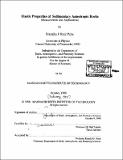Elastic properties of sedimentary anisotropic rocks : (measurements and applications)
Author(s)
Ruiz Penã, Franklin J. (Franklin José), 1962-
DownloadFull printable version (7.015Mb)
Advisor
M. Nafi Toksöz.
Terms of use
Metadata
Show full item recordAbstract
In multidisciplinary studies carried out in the Budare Oil Field of the Great Oficina Oil Field, there was difficulty matching well log synthetic seismograms with 2D and 3D seismic data. In addition, the seismically determined depths of reservoir horizons are greater than the well sonic log depths. To examine this discrepancy we conducted an experimental study of dynamic elastic parameters of the rocks in the oil field. We chose core representative samples of the lower Oficina Formation, the main reservoir of the field. The rocks selected were sandstones, sandy shales and dolomitized shales. For the velocity measurements, we used the ultrasonic transmission method to measure P-, Sh- and Sv-wave travel times as a function of orientation, and pore and confining pressures to 60 and 65 MPa, respectively. We found that, in room dry condition, most of the rocks studied are transversely isotropic. The stiffnesses constants, Young's moduli, Poisson's ratios, and bulk moduli of these rocks, were also calculated. The velocity anisotropies, together with the behavior of the elastic constants for dry rocks, indicate that: (1) the elastic anisotropy of the sandstones and sandy shales is due to the combined effects of pores, cracks, mineral grain orientation, lamination and foliation. The velocity anisotropies caused by the preferred oriented cracks decrease with increasing confining pressure. (2) For the dolomitized shales, the elastic anisotropy is due to mineral orientation and microlamination. In these cases the very high intrinsic anisotropy does not decrease with increasing confining pressure. (3) The velocities of compressional waves are greater in sandstones saturated with water than in the dry specimens, but the opposite behavior was found for shear waves. (4) The P-wave velocity anisotropy decreases after saturation; the magnitude of the decrease depends on the crack density and on the abundance and distribution of clay. (5) The Vsh-anisotropy does not show a pronounced change after saturation, and it is only slightly affected by confining pressure. Visual description, petrography and mineralogical analyses from thin sections and x-ray diffraction revealed the vertical and lateral heterogeneous nature of sandstones and sandy shales, whereas the dolomitized shale specimens looked homogeneous. The results of the laboratory measurements are consistent with an elastic model, using the equivalent medium theory for fine-layered isotropic and anisotropic media. However, in order to do reliable seismic migration and solve the problem of thickness calculations and time-to-depth conversion of surface seismic data, the ultrasonic data need to be extrapolated to low frequencies. Determining rock mechanical properties in situ is important in many applications in the oil industry such as reservoir production, hydraulic fracturing, estimation of recoverable reserves, and subsidence. Direct measurement of mechanical properties in situ is difficult. Nevertheless, experimental methods exist to obtain these properties, such as measurements of the stress-strain relationships (static) and elastic wave velocities (dynamic). We investigate the static and dynamic elastic behavior of sedimentary, anisotropic rock specimens over a range of confining and pore pressures up to 70 MPa, the original reservoir conditions. The static and dynamic properties are simultaneously measured for room dry shales, room dry sandstones, and brine saturated sandstones ...
Description
Thesis (S.M.)--Massachusetts Institute of Technology, Dept. of Earth, Atmospheric, and Planetary Sciences, February 1999. Includes bibliographical references (leaves 75-78).
Date issued
1999Department
Massachusetts Institute of Technology. Department of Earth, Atmospheric, and Planetary SciencesPublisher
Massachusetts Institute of Technology
Keywords
Earth, Atmospheric, and Planetary Sciences